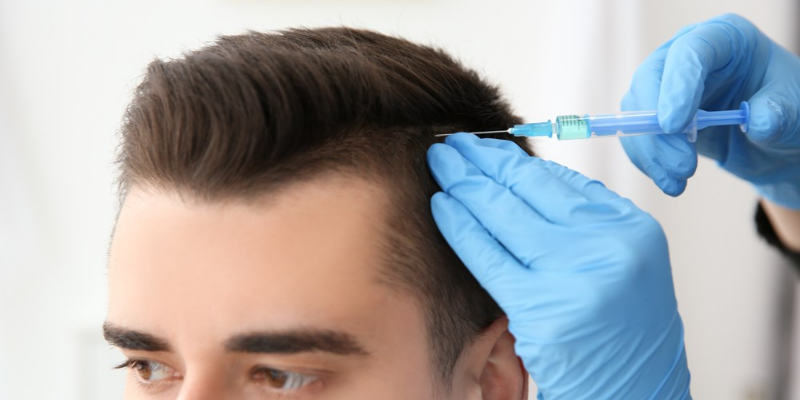Hair Implants
Hair transplants are used to thicken or replace hair in areas of the head that are weak or losing. It involves grafting hair from thicker sections of the scalp or other areas of the body to the thinner or baldness area of the scalp. Get the look you want with hair implants treatment.
Hair loss affects roughly 59% of males and 49% of women around the world, according to research. People frequently use over-the-counter medicines to combat this, include topical therapy like rogaine.
Another hair recovery method is hair transplantation. In 1939, the hair transplant procedure was tried for the first time in Japan. They used only the hairs on the scalp during the planting process. Doctors developed the “hair transplant” procedure in the decades that followed. With this procedure, we started to plant large tufts of hair.
Surgeons began to use mini- and micro-grafts to reduce the appearance of transplanted hair on the head as time went on.
Do hair implants work?
Hair implants are in most cases more effective than traditional hair transplant restoration solutions. However, there are a few things you should know:
In half-past three to four months, anywhere from 15% to 75% of the hair that has transplant will have fully grown back.
Implants hair, like natural hair, will thin with time.
Patients with inactive hair follicles (sacs beneath the skin that used to hold hair but no longer do) may have less successful transplants, but according to a 2016 research, plasma therapy can assist up to 70% of transplanted hairs entirely regrow.
Hair implants aren’t always successful. They’re mostly used to repair hair if you’re normally balding or thinned, or if you’ve lost hair because of an injury.
Since most hair transplants use the hair you have, it is not as effective in treating people with the following problems:
Baldness and extensive thinning
Medicines or other drugs used by cancer patients can cause hair loss.
Injuries to the scalp have left extensive scars on the scalp.
How Much Do Hair Implants Cost?
Hair transplant prices vary from person to person.
The ultimate cost may be determined by:
The scope of the transplantation
Surgeons in your region who are available
The Surgeon’s Expertise
Selected surgical procedure
Health insurance does not cover hair implants because they are aesthetic operations.
It may also include the cost of aftercare drugs in the final bill.
How Does A Hair Transplant Work?
The easiest definition of hair transplantation is as follows. It is the process of taking the hair you have and transferring it to an empty space that you do not have. It is usually obtained from the nape, although other parts of your body can also use it.
Your doctor disinfects the region where the hair will take and numbs it with a local anesthetic before beginning the transplant. You can even ask for medication if you want to sleep through the process.
Following that, your surgeon will use one of two implant methods: FUT or FUE.
Follicular unit transplantation (FUT) and Hair Implants
FUT is also known as follicular unit strip surgery (FUSS). Following these stages, your doctor will perform a FUT procedure:
The surgeon removes a section of your scalp, generally from the back and side of your head, with a knife. Typically, the strip is 7 to 9 inches long, although it can run from cheek to cheek.
Stitching are used to seal the wound in which the scalp takes.
A scalpel is used to cut the head strips into smaller bits by your doctor and their assistance. They could sever the chunk into as many as 2,000 smaller bits known as grafting. Only one hair may be present in some of these grafts.
The surgeon cuts tiny holes on your head with a needle or blades where hair will transplant.
The physician inserts into the punctured holes hairs from the scalp removal. Grafting is the term for this procedure.
They next use dressings or gauze to cover the surgery wounds.
The amount of grafts you get is determined by the following factors:
What Kind of Hair You Have
The size of the transplant location, the quality of the hair (including length), and the coloring of the hair
Follicular Unit Extraction (FUE)
Your physician follows these steps to complete a FUE procedure:
Someone shave away hair on the back of your head.
The surgeon then removed from the scalp skin individual follicles. We extracted each follicle, leaving microscopic scars.
The surgeon inserts small holes in your head, similar to the FUT operation, and graft hair follicles into them.
We then applied dressings or gauze to the surgical site.
FUT and FUE healing might take anywhere from a few days or weeks. This is partly determined by the surgeon’s scope of work. We will complete the treatment on the same day as you return home.
Your doctor will gently remove any gauze when the procedure is complete. Your physician may insert triamcinolone into the region to reduce swelling if it swells.
You’ll most likely experience hurt or soreness at the transplantation location as well as the place where your hair remove. Your doctor may prescribe the following over the next few days:
Anti-inflammatories, such as an oral statin, to ease swelling finasteride or Rogaine to assist speed up hair growth
Following are some hair implants treatment aftercare suggestions:
Do not wash your hair for a few days following the surgery. During the first few weeks, just use light shampoo.
In around 3,5 days, you must be available to work or do usual activities.
For around 3,5 weeks, don’t use a brush or comb on the new grafts.
Wear no caps, pullover shirts, or coats until your doctor gives you the okay.
For about a week, don’t exercise.
Don’t be concerned if a few hairs fall out. This is a normal component of the procedure. For a few months, implanted hair may not regrow much or blend in with the hair surrounding it.
Before deciding on either hair implants technique, see your doctor or a transplant surgeon.
Recognize that both operation is certain to work, and that scar is a possibility. You may also be ineligible for either operation due to the volume or condition of your hair.
Getting Hair Implants, Turkey Istanbul
For those considering getting hair implants, Turkey Istanbul offers the best and most experienced surgeons. Whether you are looking for traditional hair implants or a more modern follicular unit extraction, these surgeons will be able to provide the best results for you. They are also very knowledgeable about the latest treatments and technologies available for hair implants, so you can rest assured that you will be getting only the best service possible. Furthermore, with great prices and excellent aftercare services, there is no reason not to choose Istanbul as your destination of choice when it comes to getting Turkish hair implants.

Be sure to review all documents provided by the clinic thoroughly so that you understand what is involved in hair implants Turkey Istanbul surgery including any potential risks or complications associated with it. Speak with the staff at a variety of clinics and ask questions about their experience and qualifications, as well as any potential risks or complications associated with the procedure. Make sure that both you and your doctor are comfortable with all aspects of the procedure before proceeding. With good research, you can also learn the hair implant Istanbul cost.





